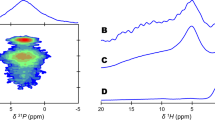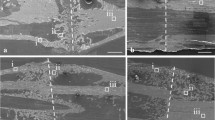Summary
Early mineral deposits within calcifying rat epiphyseal growth plates were studied by bright field and selected-area dark field electron microscopy, and X-ray microanalysis. These mineral deposits were preparedin situ by high-pressure freezing, freeze substitution, and low-temperature embedding, and were examined in unstained, stained, and ethyleneglycol tetraacetic acid (EGTA)-treated stained thin sections. On unstained sections mineral rods occur within an amorphous density of calcium and phosphorus (CaP). X-ray microanalysis of stained sections reveals that the location of electron-dense deposits does not always correspond to that of the CaP mineral deposits identified in electron microscopic images. Such an analysis showed a depletion of both Ca and P in stained sections at sites corresponding to high levels of these elements in unstained sections. Staining thus demineralizes early deposition sites of CaP; at the same time lead (Pb) and uranium (U) bind to the organic components of the extracellular matrix formerly associated with Ca and P. This substitution phenomenon alters the overall fine structure of mineral sites by depleting the amorphous density of Ca and P, and by creating isolated rodlike structures that have formerly been interpreted as representing hydroxyapatite (HAP) crystals. Selected-area dark field imaging shows nascent sites of HAP crystals to be associated with the limiting membrane of matrix vesicles, but such crystals were undetectable at these sites with conventional bright field images. Dark field imaging also showed that the typical 30–80 nm crystal rods found in calcified cartilage consist of aggregates of HAP crystals.
Similar content being viewed by others
References
Hunziker EB, Hermann W, Schenk RK, Mueller M, Moor H (1984) Cartilage ultrastructure after high pressure freezing, freeze substitution, and low temperature embedding. I. Chondrocyte ultrastructure—implications for theories of mineralization and vascular invasion. J Cell Biol 98:267–276
Arsenault AL (1985) Fine structure and elemental maps of the calcifying epiphysis preserved by slam freezing and freeze substitution. In: Butler WT (ed) The chemistry and biology of mineralized tissues. Ebsco Media, Inc, Birmingham Alabama, pp 364–367
Arsenault AL, Ottensmeyer FP, Heath IB (in press) An electron microscopic and spectroscopic study of murine epiphyseal cartilage: analysis of fine structure and matrix vesicles preserved by slam freezing and freeze substitution. J Ultrastruct Mol Struct Res
Boothroyd B (1964) The problem of demineralization in thin sections of fully calcified bone. J Cell Biol 20:165–173
Landis WJ, Glimcher MJ (1978) Electron diffraction and electron probe microanalysis of the mineral phase of bone tissue prepared by anhydrous techniques. J Ultrastruct Res 63:188–223
Bishop MA, Warshawsky H (1982) Electron microscopic studies on the potential loss of crystallites from routinely processed sections of young enamel in the rat incisor. Anat Rec 202:177–186
Nanci A, Bai P, Warshawsky H (1983) The effect of osmium postfixation and uranyl and lead staining on the ultrastructure of young enamel in the rat incisor. Anat Rec 207:1–16
Venable JH, Coggeshall R (1965) Simplified lead citrate stain for use in electron microscopy. J Cell Biol 25:407–408
Grynpas MD, Bonar LC, Glimcher MJ (1984) X-ray diffraction radial distribution function studies on bone mineral and synthetic calcium phosphates. J Mater Sci 19:723–736
Bonucci E (1967) Fine structure of early cartilage calcification. J Ultrastruct Res 20:33–50
Bonucci E (1969) Further investigations on the organic/inorganic relationships in calcifying cartilage. Calcif Tissue Res 3:38–54
Bonucci E (1971) The locus of initial calcification in cartilage and bone. Clin Orthop Rel Res 78:108–139
Arsenault AL, Hunziker EB (1986) Electron microscopic and spectroscopic analysis of matrix vesicles from the epiphyseal growth plate: cryogenic tissue preparation. In: Ali Y (ed) Cell mediated calcification and matrix vesicles. Elsevier Science Publishers, Amsterdam, The Netherlands pp 17–20
Boothroyd B (1975) Observations on embryonic chick-bone crystals by high resolution transmission electron microscopy. Clin Orthop Rel Res 106:290–310
Landis WJ, Paine MC, Glimcher MJ (1977) Electron microscopic observations of bone tissue prepared anhydrously in organic solvents. J Ultrastruct Res 59:1–30
Landis WJ, Hauschka BT, Rogerson CA, Glimcher MJ (1977) Electron microscopic observations of bone tissue prepared by ultracryomicrotomy. J Ultrastruct Res 59:185–206
Termine JD (1972) Mineral chemistry and skeletal biology. Clin Orthop Rel Res 85:207–241
Anderson HC (1969) Vesicles associated with calcification in the matrix of epiphyseal cartilage. J Cell Biol 41:59–72
Ali YS, Craig Gray J, Wisby A, Phillips M (1977) Preparation of thin cryosections for electron probe analysis of calcifying cartilage. J Microsc 111:65–76
Landis WJ, Glimcher MJ (1982) Electron optical and analytical observations of rat growth plate cartilage prepared by ultracryomicrotomy: the failure to detect a mineral phase in matrix vesicles and the identification of heterodispersed particles as the initial solid phase of calcium phosphate deposited in the extracellular matrix. J Ultrastruct Res 78:227–268
Steve-Bocciarelli D (1970) Morphology of crystallites in bone. Calcif. Tissue Res 5:261–269
Jackson SA, Cartwright AG, Lewis D (1978) The morphology of bone mineral crystals. Calcif. Tissue Res 25:217–222
Weiner S, Price PA (1986) Disaggregation of bone into crystals. Calcif Tissue Int 39:365–375
Author information
Authors and Affiliations
Rights and permissions
About this article
Cite this article
Arsenault, A.L., Hunziker, E.B. Electron microscopic analysis of mineral deposits in the calcifying epiphyseal growth plate. Calcif Tissue Int 42, 119–126 (1988). https://doi.org/10.1007/BF02556344
Received:
Revised:
Issue Date:
DOI: https://doi.org/10.1007/BF02556344




